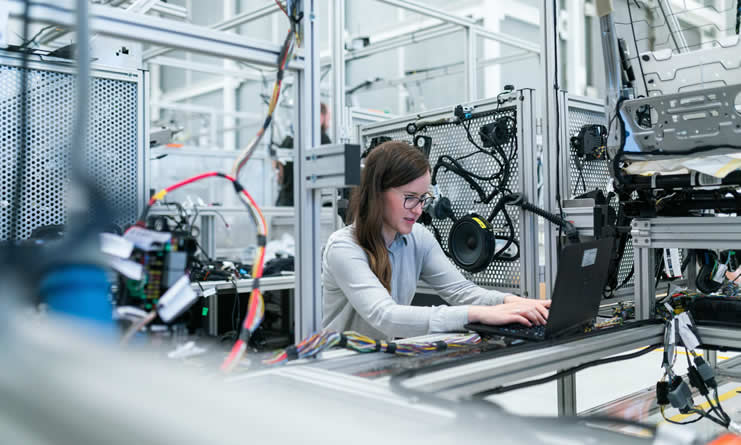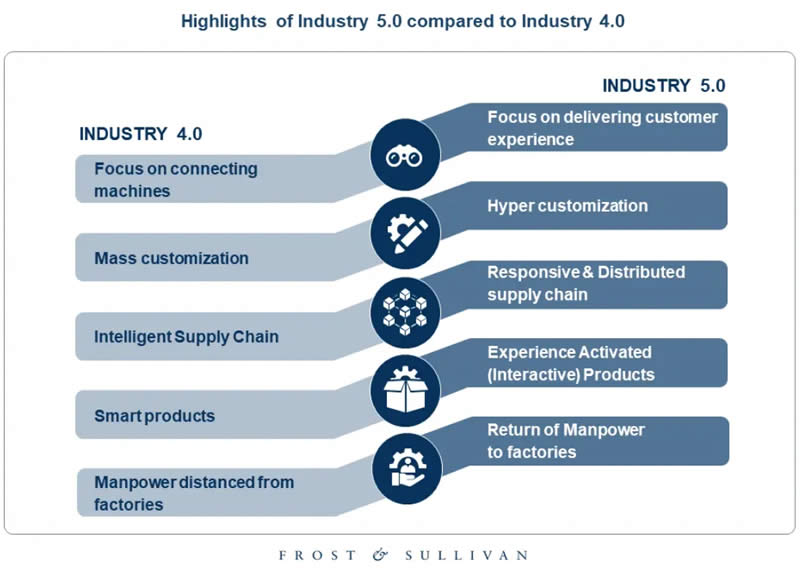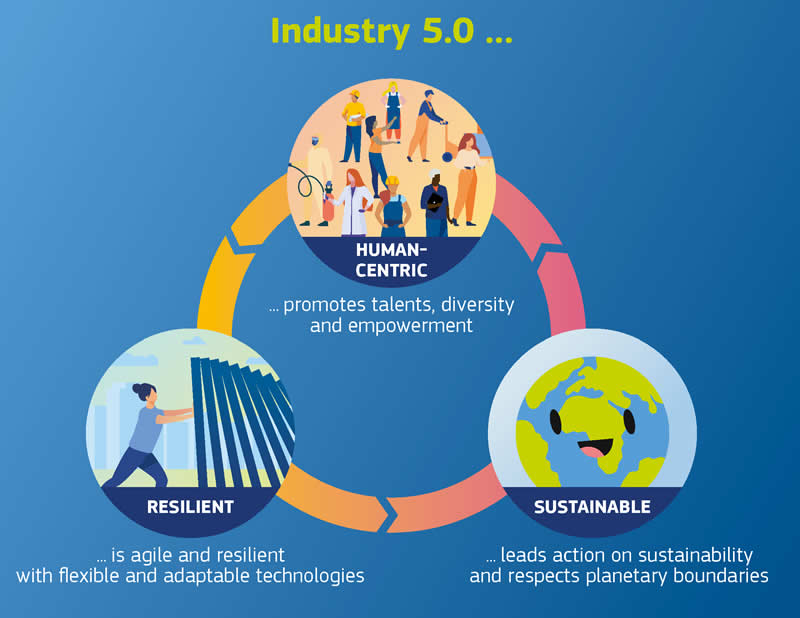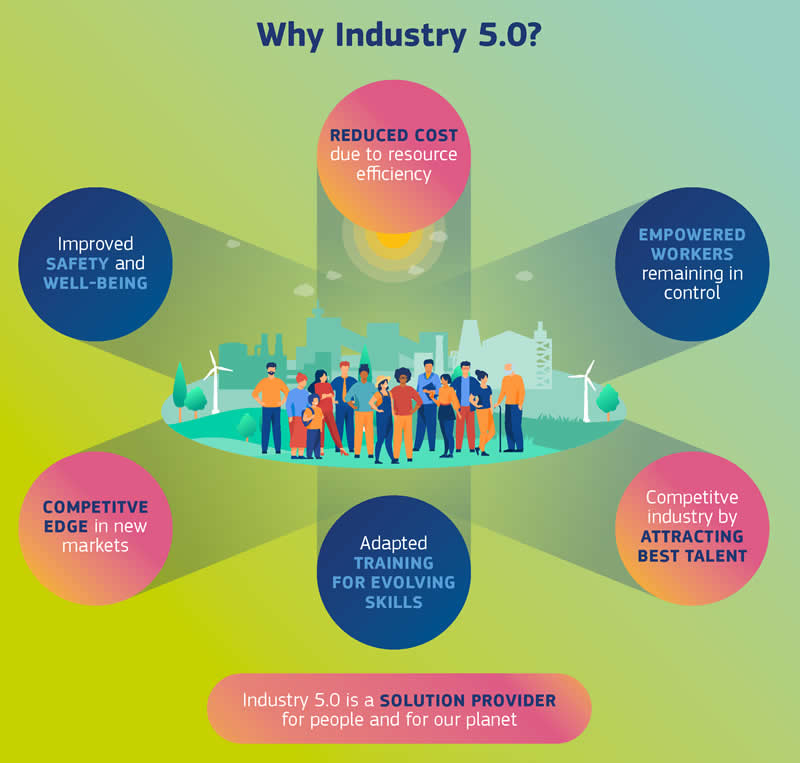The term Industry 5.0 popped up several years ago as a reaction to the vision of Industry 4.0. Driven by the impact of the pandemic, the focus on topics such as sustainability and resilience, and the call to put people more central again, it has become a subject policymakers and organizations increasingly pay attention to.
Industry 5.0 shifts the focus from the shareholder value to stakeholder value and reinforces the role and the contribution of industry to society.
In 2011 the vision of Industry 4.0, initially meant for the German (manufacturing) industry, was officially presented at the Hannover Messe fair. In 2017, Japan shared its vision on a concept called Society 5.0 at the CeBIT fair, also in Germany. And for several years, you might have come across the term Industry 5.0. If you haven’t yet, you undoubtedly will.

Perhaps it all becomes a bit confusing, so here’s what you need to know. Industry 4.0 is essentially driven by cyber-physical convergence, enabled by IoT (the Internet of Things), supporting technologies, digit(al)ization, automation, and the convergence of IT and OT (short for operational technology but also about people and teams specialized in it, like with IT). There are more technologies and elements, such as the so-called cyber-physical systems, horizontal and vertical integration, the move from industrial automation to industrial digital transformation, connected value chains, and more. We’ve explained all this in-depth in our Industry 4.0 guide.
Although this originally wasn’t sure, the vision of Industry 4.0 is also tied to the notion of a fourth industrial revolution, in which we are living.

While various countries across the globe had similar initiatives, Industry 4.0 became known worldwide but still predominantly has a European connotation. This European dimension is also present in the idea of Industry 5.0 or, at least, in the way Industry 5.0 ‘evolves.’ As a term and vision, Industry 5.0 isn’t a European nor new ‘invention’ (see the examples of and links to Frost & Sullivan, and the ISA or International Society of Automation below), but the EU firmly pushes it in a somewhat adapted vision for the future whereby the notion of a sustainable industry also comes far more in the picture.
Industry 5.0 – not another revolution, a complement (or correction if you will)
Industry 5.0 is not related to yet another industrial revolution; that would be pretty absurd.
For the record and your information: in the US, where the term Industrial IoT, originally in the sense of Industrial Internet (hence the ‘Industrial Internet Consortium or IIC), is often used instead of Industry 4.0, the vision was that we’d entered a third (3rd) industrial revolution. And in Japan, with Society 5.0, a much broader concept, they have started a, you guessed it, fifth industrial revolution. Everything is relative and industrial revolutions these days are a matter of vision.
For the record and your information: in the US, where the term Industrial IoT, originally in the sense of Industrial Internet (hence the ‘Industrial Internet Consortium or IIC), is often used instead of Industry 4.0, the vision was that we’d entered a third (3rd) industrial revolution. And in Japan, with Society 5.0, a much broader concept, they have started a, you guessed it, fifth industrial revolution. Everything is relative and industrial revolutions these days are a matter of vision.
Yet, away from revolutions and back to Industry 5.0. The EU sees Industry 5.0 as a complement to Industry 4.0 and has placed it high on its agenda. The research and consulting firms and experts who started talking about the need for an Industry 5.0 (also elsewhere) all ‘invented’ the term for more or less the same reasons the EU embraced it.
As reminded in an article on lights-out processes and manufacturing, in the staged vision of Industry 4.0, much attention goes to autonomous and semi-autonomous processes, hyper-automation, advanced robotics, self-optimizing systems, data exchanges; you name it. This is especially the case in more ‘mature’ or ‘advanced’ stages, which no organization and market as far as we know have reached.
Industry 5.0 is a model of the next level of industrialization characterized by the return of manpower to factories, distributed production, intelligent supply chains and hyper customization, all aimed to deliver a tailored customer experience time after time (Frost & Sullivan)
In other words: Industry 4.0 feels quite, let’s say, ‘cold.’ Tech, data, ecosystems, machines, and all those intelligent environments enabled by OT and IT, are perhaps more for a specific audience. By the way, the latter also encompasses IT technologies that are known and adopted for many years in other sectors, such as cloud computing, various forms of AI and automation technologies, and big data (analytics). By the way, number two, saying that the pioneers behind Industry 4.0 and similar visions in other regions didn’t talk about people, society, and environment is incorrect. Yet, it’s far from sufficient for this day and age.

How Industry 5.0 fits in the (post)-pandemic narrative and accelerated priorities
With Industry 5.0, many people wanted to bring the human, social, and environmental dimensions back into the equation. They felt this wasn’t the case in Industry 4.0 and initially mainly focused on the human touch.
One of them is Frost & Sullivan. On this page, you can read what the company means with Industry 5.0, how it compares to Industry 4.0, and some technology enablers.
A quote from the 2019 article: “Industry 4.0 relies heavily on automation and has been intimidating workers on factory shop floors. Frost & Sullivan envisions a futuristic scenario of the next big thing—Industry 5.0, which will bring back empowered humans to the shop floor.”
In an older article the ISA (International Society of Automation) also wrote about it, with a focus on cobots (the article is by Esben H. Østergaard, PhD, nowadays CEO at REInvest Robotics). Quote from the article: “By placing humans back at the center of industrial production, Industry 5.0 gives consumers the products they want and gives workers jobs that are more meaningful.”
So, Industry 5.0, as we know it now, brings in this ‘human’ touch and several topics that receive much attention nowadays. Among all these topics: resilience (business resilience and cyber resilience), sustainability and environment, purpose and values/ethics/diversity, circular economy, the place of people in a future of work with more human-machine collaboration, human-centric solutions, and, well, also some technical matters.
Industry 5.0 recognizes the power of industry to achieve societal goals beyond jobs and growth to become a resilient provider of prosperity, by making production respect the boundaries of our planet and placing the wellbeing of the industry worker at the center of the production process.
And of course quite some business and economic progress. ‘People first’ also means skilled workers (and we lack digital factory skills), training, and a focus on talent, on top of ’empowered workers’ who can count on improved safety and wellbeing, all topics in future of work debates.
It is indeed not a coincidence that the attention for Industry 5.0 is accelerating now. Just as the COVID-19 pandemic accelerated digital transformation, it accelerated the focus on other challenges of our time and the importance of people, environment, and societal changes.
However, just as is the case with another phenomenon that existed before but now gets loads of attention, hybrid working models, the drivers behind Industry 5.0 aren’t new. It’s just that they are adapted to the modern Zeitgeist – and accelerated by it.
To resume: Industry 5.0 is a complement to Industry 4.0 and mainly focuses on a sustainable, human-centric, and resilient industry.

The images from the infographic above tell more, albeit with a European focus (full PDF here). Will Industry 5.0 also become a ‘thing’ outside the EU? Well, the drivers are there, as are the technologies (more about those later). Moreover, the term and ideas behind it live for quite some years in many countries. Regardless of the terms and European policies behind it, it’s clear that the same evolutions exist elsewhere, and as is the case in politics, talks are taking place on all mentioned topics in what does remain a bit of a globalized economic reality, despite everything that happened in recent years. And, as we saw, the term Industry 5.0 is anything but new or European.
PS: do note that Industry 5.0 in no way is only for companies that are further in their Industry 4.0 journey. Well on the contrary.
More on the Industry 5.0 page of the European Commission
Top image: Photo by ThisisEngineering RAEng on Unsplash – all other images belong to their respective mentioned owners. Images serve illustration purposes.

